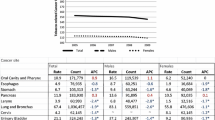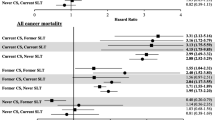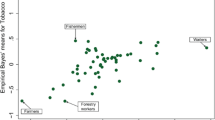Abstract
A report of an increased risk of soft tissue sarcoma (STS) among users of smokeless tobacco led us to evaluate this association and the role of other types of tobacco in a prospective cohort mortality-study of United States veterans. A total of 248,046 veterans provided tobacco-use histories on a mail questionnaire in 1954 or 1957. Data on subsequent tobacco use were not collected. By 1980, 119 deaths from STS had occurred among the cohort members. Veterans who had ever chewed tobacco or used snuff had a nonsignificant 40 percent excess of STS (95 percent confidence interval [CI]=0.8–2.6; 21 deaths) in comparison with veterans who had never used any tobacco products. Risk was limited to former users (relative risk [RR]=1.5) with no excess seen among current users (RR=0.9). Frequent former users had higher risk (RR=1.9) than infrequent users (RR=1.3). Risk was slightly higher in persons who started using smokeless tobacco at younger ages, but did not increase with duration of use or with late age at cessation of use. Most veterans who used chewing tobacco or snuff also used some other form of tobacco. No STS deaths occurred among the 2,308 veterans who used smokeless tobacco only. An unexpected finding of the study was the significant excess of STS deaths among cigarette smokers (RR=1.8, CI=1.1–2.9). Risk was higher among ex-smokers (RR=2.2) than among current smokers (RR=1.5) and was not related to number of cigarettes per day, age started smoking, duration, or pack-years. Pipe and cigar smokers also experienced a nonsignificant excess risk (RR=1.6). The study findings may have been affected by limitations in the histories of tobacco use, the quality of death certificate data on STS, and the small number of STS deaths, particularly among users of smokeless tobacco.
Similar content being viewed by others
References
Winn, DM. Tobacco chewing and snuff dipping: an association with human cancer. In: O'Neill, IK, von, Borstel, RC, Miller, CT, et al, eds. N-Nitroso Compounds: Occurrence, Biological Effects and Relevance to Human Cancer. New York: oxford University Press, 1984: 837–49.
National Institutes of Health Consensus Development Panel. National Institutes of health consensus development conference statement: health implications of smokeless tobacco use. January 13–15, 1986. Ca-A Cancer J for Clin 1986; 36: 310–6.
Hoffman, D, Harley, NH, Fisenne, I, et al. Carcinogenic agents in snuff. JNCI 1986: 76: 435–7.
Hoffman, D, Adams, JD, Lisk, D, et al. Toxic and carcinogenic agents in dry and moist snuff. JNCI 1987; 79: 1281–6.
Johansson SL, Hirsch JM, Larsson P-A, et al. Snuffinduced carcinogenesis: effect of snuff in rats initiated with 4-nitroquinoline N-oxide. Cancer Res 49: 3063–9.
Zahm, SH, Blair, A, Holmes, FF, et al. A case-control study of soft-tissue sarcoma. Am J Epidemiol 1989; 130: 665–74.
Kahn, HA. The Dorn study of smoking and mortality among US veterans: report of eight and one-half years of observation. NCI Monogr 1966; 19: 1–126.
Rogot, E, Murray, JL. Smoking and causes of death among US Veterans: 16 years of observation. Public Health Rep 1980; 95: 213–22.
World Health Organization. Manual of the International Statistical Classification of Diseases, Injuries and Causes of Death. Seventh revision. Geneva: United Nations, 1957.
Breslow, NE, Day, NE. Statistical Methods in Cancer Research. Vol. II: The Design and Analysis of Cohort Studies. Lyon, France: International Agency for Research on Cancer, 1987; IARC Sci. Pub. No. 82: 113–4, 120–59.
Hoar, SK, Blair, A, Holmes, FF, et al. Agricultural herbicide use and risk of lymphoma and soft-tissue sarcoma. JAMA 1986; 256: 1141–7.
Percy, C, Stanek, E, Gloeckler, L. Accuracy of cancer death certificates and its effect on cancer mortality statistics. Am J Public Health 1981; 71: 242–50.
Hardell, L, Sandstrom, A. Case-control study: soft tissue sarcomas and exposure to phenoxyacetic acids or chlorophenols. Br J Cancer 1979; 39: 711–7.
Gebauer, C. Primary pulmonary sarcomas: etiology, clinical assessment and prognosis with a comparison to pulmonary carcinomas—a review of 41 cases and 394 other cases of the literature. Japn J Surg 1982; 12: 148–59.
Kang, H, Enzinger, F, Breslin, P, et al. Soft tissue sarcoma and military service in Vietnam: a case-control study. JNCI 1987; 79: 693–9.
Vineis, P, Terracini, B, Ciccone, G, et al. Phenoxy herbicides and soft-tissue sarcomas in female rice weeders: a population-based case-referent study. Scand J Work Environ Health 1987; 13: 9–17.
Woods, JS, Polissar, L, Severson, RK et al. Soft tissue sarcoma and non-Hodgkin's lymphoma in relation to phenoxyherbicide and chlorinated phenol exposure in western Washington. JNCI 1987; 78: 899–910.
Hardell, L, Eriksson, M. The association between soft tissue sarcomas and exposure of phenoxyacetic acids: a new case-referent study. Cancer 1988; 62: 652–6.
Serraino, D, Franceschi, S, Talamini, R, et al. Non-occupational risk factors for adult soft-tissue sarcoma in northern Italy. Cancer Causes Control 1991; 2: 157–64.
Grufferman, S, Wang, HH, Delong, ER, et al. Environmental factors in the etiology of rhabdomyosarcoma in childhood. JNCI 1982; 68: 107–13.
Hartley, AL, Birch, JM, McKinney, PA, et al. The inter-Regional Epidemiological Study of Childhood Cancer (IRESCC): case control study of children with bone and soft tissue sarcomas. Br J Cancer 1988; 58: 838–42.
Myers, MH, Hankey, BF. Cancer patient survival in the United States. In: Schottenfeld, D, Fraumeni, JF Jr, eds. Cancer Epidemiology and Prevention, Philadelphia: WB Saunders, 1982: 166–78.
Marty, PJ, McDermott, RJ, Williams, T. Patterns of smokeless tobacco use in a population of high school students. Am J Public Health 1986; 76: 190–2.
Additional information
Drs Zahm and heineman are with the Occupational Studies Section, Environmental Epidemiology Branch, Epidemiology and Biostatistics Program, National Cancer Institute, Rockville, MD, USA. Dr Vaught is with Westat, Inc., Rockville, MD. USA. Address correspondence to Dr Zahm, Occupational Studies Section, National Cancer Institute, Executive Plaza North, Room 418, Rockville, MD 20892, USA.
Rights and permissions
About this article
Cite this article
Zahm, S.H., Heineman, E.F. & Vaught, J.B. Soft tissue sarcoma and tobacco use: data from a prospective cohort study of United States veterans. Cancer Causes Control 3, 371–376 (1992). https://doi.org/10.1007/BF00146891
Received:
Accepted:
Issue Date:
DOI: https://doi.org/10.1007/BF00146891




